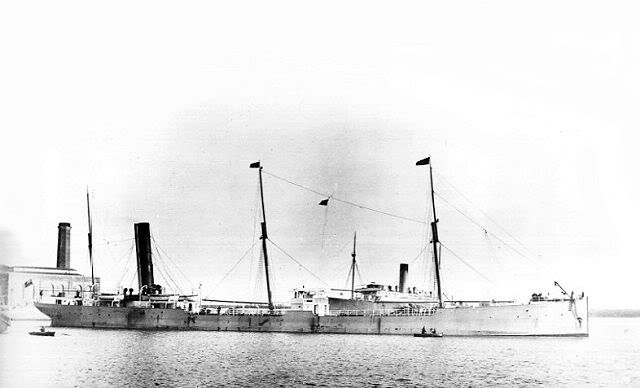Auke Visser´s Esso UK Tanker's site | home
Ottawa - (1900-1921)

Build as "Elbruze" for the Kerosene Co., Ltd. (Lane & MacAndrew) in 1888, 2742 grt by Armstrong, Mitchell & Co.,
Newcastle (523)
She was renamed Ottawa in 1900 when sold to the Anglo-American Oil Company Ltd., and managed by J. H. Usmar.
Measurements : 309 feet length X 40 feet breadth
Engine : T3cyl.
1895: (Galbraith, Pemsbrooke & Co.).
1900: "Ottawa" (Anglo-American Oil Company).
6.2.1921: In wireless commumcation, but then went missing
(voyage: Port Lobos/Manchester-fuel oil).
She was involved in a curious incident relating to the sinking of the Titanic. On 6 June 1912, nearly 3 months after the disaster,
Ottawa picked up the body of a man wearing a lifebelt. The body was very much de-composed, especially the hands and face. In a
document lodged at the National Archives in Washington, DC pertaining to the Titanic disaster is an interesting letter written by
Thomas Cook, 3rd Officer of the Ottawa. He states that when Ottawa, under the command of Captain R.G. Tait, stopped and picked
up the body it was reasonably obvious that the male had come from Titanic. The ships name on the lifebelt had been washed
off but upon searching the clothes a wallet was found bearing the initials W.T.K. and containing various documents including a
love letter and a business card re- ‘Apartments’ in Margate, Kent. The body was given a proper sea burial according to the ce-
remony of the Church of England. Mr. Cook goes on to state that they had since ascertained that his name was W.T. Kerley
and that he had been an assistant steward on the Titanic and that the body was found 543 miles from Titanic’s position.
Mr. W.T. Kerley’s name does not feature in the list of lost and saved published by Senator Smith’s committee in the wake of the
disaster. Even though notification of the recovery, identification and burial of the body had been forwarded to the United States
Government by Captain Tait it appears that by early July 1912, when information was received by the Hydrographic Office, the
news media had turned to other matters and word of Kerley’s identification never made it to the major newspaper pages.
Ottawa’s fate was also a mystery as she was listed as missing with all hands from 6 February 1921 while on voyage Port Lobos
to Manchester.
The Ottawa was in Admiralty service between August 1914 and December 1918. On 21st January, 1921, she sailed from Mexico
for Manchester with a bulk cargo of 3,600 tons of fuel oil, routed via Norfolk, Virginia, from where she left on 2nd February.
Subsequently, the tanker was in wireless telegraphy communication with other vessels, the last one, the British steamer Dorington
Court, on 6th February. Shortly after, there was a hurricane in the area, in which the French steamer Victorieux (1911, 5,692 gt) and
the Belgian-owned Bombardier (1920, 3,162 gt) were abandoned.
There is little doubt that the Ottawa was also a victim of the storm, for the British-flag steamer Esperanza de Larrinaga (1907, 4,981 gt)
and the Italian vessel Monte San Michelle (1920, 6,547 gt), which, respectively, sailed on the same day from Norfolk and New York,
also went missing.